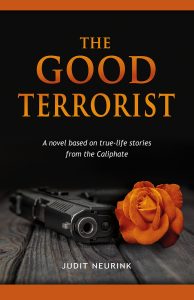When the Light Wins From the Dark

Photo by Rob Huibers
For about five years, the rise and fall of the Islamic Terror group ISIS and its Caliphate in Iraq and Syria dominated my life. As the only Dutch correspondent in Iraq, this was the main subject I covered. And the reporting had multiple effects on my own life. The interviews with Yezidi women who had been kidnapped clouded my moods, although the stories about their subsequent recue from the Caliphate provided me with a silver lining.
I tried desperately to understand how female ISIS members could be denying any responsibility to the horrors the group brought about to see many people. And after ISIS was evicted Iraq, I tried hard to imagine what it was like to pick up your life after having lived under the cruel ISIS occupation for three years. Yet for all these thoughts and emotions, there was no space in my journalistic work, and not even in the non-fiction books I wrote about ISIS in that period.
I simply could not accept the kind of evil ISIS was so proudly showing off, for it affected my image of the region that I had come to love. I was convinced that black was not only the color left out there. Therefore, I had to find positives. There weren’t many, although the horrors also had some positive effect for Yezidi women, as many of them had since their escape been giving a bigger role inside their community.
For many people, out of evil and pain nothing positive could be born, but for me and the survivors that was a necessity. From this urge, The Good Terrorist was born. It is a novel in which I used my knowledge by painting situations that could have happened, against a background that is very near to reality. It shows the process of radicalization of youth and the impotence of parents to deal with it. And that even within a cruel macho culture, people will try to do good and resist.
The way I wanted to layer the stories about radicalization, violence, victimhood, bravery, and survival doesn’t fit non-fiction. For I wanted to show what radicalism and war mean to human lives and in how many ways people can survive. Because of the combination of phantasy and reality, it is not always clear where one starts and the other ends. Yes, there has been a father who has managed to save his son from the Caliphate. Yes, some ISIS members were declared dead and later surfaced again. Have Yezidi women been helped with anti-conception pills? It might have been.
My main questions when writing the book were: Is there love, hate and friendship inside the Caliphate? How do you survive in this land of terror, and is it even possible to get out of it alive?
My main character is high school teacher Rose, who finds to her shock that her former husband Ahmed is said to be killed in the Caliphate. It seems he went to in to save his son who had been recruited through friends. While Rose is still in denial, her new lover Sam, who is also his best friend, decides to find out what really happened. When Rose is contacted by Dua, a Yezidi woman who used to work with Ahmed in the Caliphate, she finds he was secretly helping these kidnapped women to escape. She manages to read his diary, which shows a struggle for humanity under the rule of a group that imposed its brand of Islam on large parts of Iraq and Syria.
The Good Terrorist is a story of religion abused in their hands, of violence, and slavery. But also, of the brave men and women standing up against it. About the light winning from the darkness. About hope and laughter, even at the worst of times.
—
The Good Terrorist; A novel based on true-life stories from the Caliphate
 Rose is shocked to hear her husband died in the Caliphate. His best friend becomes her lover. Together will they be able to find out the truth of what happened?
Rose is shocked to hear her husband died in the Caliphate. His best friend becomes her lover. Together will they be able to find out the truth of what happened?
Is there love, hate and friendship inside the Caliphate, the Islamic state that the radical Muslim group ISIS created in Iraq and Syria? How do you survive in this land of terror, and is it possible even to get out of it alive?
The Good Terrorist is the story of Rose, who finds herself confronted with these questions when she is told her former husband was killed in the Caliphate. While she is still in denial, her new lover, who is also his best friend, decides to find out what really happened.
And the story of Dua and Amina, two Yezidi women captured by ISIS to become sex slaves, and the secret networks set up to get them out.
It is the story of a struggle for humanity under a rule of a group that imposed its brand of Islam on large parts of Iraq and Syria. A story of religion abused in their hands, violence, and slavery. But also of brave men and women standing up against it.
Quentin Sommerville, BBC-reporter: “The tension in Judit Neurink’s latest novel is like a weight upon your chest, rich in detail it captures the fear and uncertainty as Islamic State’s emerged, and the group’s ability to reach far beyond its borders into the lives and minds of recruits in the west.”
Boris O. Dittrich, Novelist and Senator in the Netherlands: “I simply could not put down ‘The Good Terrorist’ and loved travelling under Neurink’s guidance to the Caliphate. And am happy to be back!”
BUY HERE
—
Judit Neurink (1957) reported on the rise and fall of terror group ISIS, while working as a correspondent in Iraq for Dutch and international media (2008-2019). She wrote ‘The war on ISIS’ and ‘Slaves wives and brides’, the latter about women caught up inside the Caliphate. Her book ‘Violence Recycled’ (2021) is a personal report of a decade in Iraq while it moved from war to peace and back again. Her bestselling novel is The Jewish Bride, about the lost Jewish past of Iraq. The Good Terrorist is her ninth book. Her website is www.juditneurink.eu. Find her on Twitter (@JuditNeurink) and Facebook (https://www.facebook.com/judit.neurink.authorpage)
Category: On Writing

























